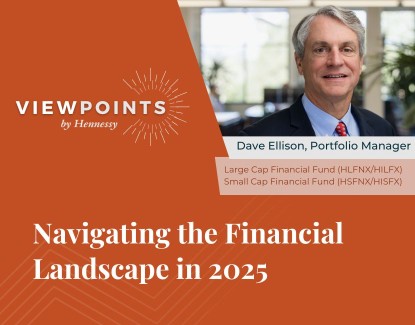Perspective on the Financial Sector
Portfolio Managers Dave Ellison and Ryan Kelley discuss their perspective and outlook on the banking industry, banks’ net interest margins and valuations. They also discuss the allocation of the Large Cap Financial Fund and the attributes they seek in smaller banks for the Small Cap Financial Fund.
-
 David EllisonPortfolio Manager
David EllisonPortfolio Manager -
 Ryan C. Kelley, CFAChief Investment Officer and Portfolio Manager
Ryan C. Kelley, CFAChief Investment Officer and Portfolio Manager
What is your overall perspective and outlook for the Financials Industry?
In general, we believe the industry has been in solid shape as it relates to capital, earnings, and liquidity for a number of years even with interest rate fluctuations, Federal Reserve actions, and regulatory changes.
While loan demand remains low, loan balances have increased. From end of year 2021 through 2023, FDIC-insured bank loan balances have increased from $11.2 trillion to $12.5 trillion, an increase of 7%. In addition, if the U.S. continues to have a strong economy with moderating inflation and the Fed reduces interest rates, there may be an increase in loan demand to keep up with a growing economy.
The industry faces a challenge in maintaining and growing bank deposits. With the rise of electronic banking, customers can move money from one bank to another very quickly. If money is withdrawn from a bank, those funds are no longer available to lend. Fewer deposits could curtail lending activity, potentially affecting demand for products and services.
As a result, the market has been favoring larger banks. Over the past year through March 31, 2024, the Russell 1000 Financial Index, made of larger financial stocks, rose 37% while the Russell 2000 Financial Index, comprised of smaller financial stocks, gained 21%. Year-to-date as of March 31, 2024, large-cap financials rose nearly 13% while their smaller peers lost almost 2%.
Would you please provide an update on banks’ net interest margins?
The net interest margin, or NIM, of a bank is the difference between income the banks are generating from loans and their cost of funds or deposits. Particularly for smaller banks, the NIM drives the majority of its profitability and earnings.
In 2023, U.S. commercial banks, which account for approximately 95% of industry assets, had a 3.18% average NIM, which has expanded over the past two years from 2.47%. Small savings banks’ average NIM has been even higher. These U.S. savings banks, which comprise less than 5% of industry assets, had a 4.26% average NIM, the highest it has been since 1991.
How do bank valuations compare to the broader market and on a historical basis?
The Financials sector has seen valuation multiple compression over the past few years and today look extremely inexpensive compared to the overall market as well as their historical long-term averages.
As of 4/30/24, the KBW Bank Index traded at 11.0x 2024 estimated earnings, approximately half of the S&P 500, which is trading at 20.6x. The KBW Bank Index’s price-to-earnings ratio was also well below its 10-year average of 12.6x.
Would you please discuss the allocation among traditional banks and non-bank financial institutions in the Large Cap Financial Fund?
As of March 31, 2024, the Hennessy Large Cap Financial Fund has approximately 55% allocated to diversified and regional banks, 16% to payment processing companies such as MasterCard and Visa, 10% to investment banks, 7% to consumer finance, and 5% to financial exchanges.
The largest positions as of the end of the first quarter include J.P. Morgan Chase and Bank of America, which are large, diversified Financial companies, followed by Mastercard and Visa. These payment processing companies tend to be less sensitive to the Fed’s rate actions and the shape of the yield curve.
What attributes do you seek in smaller banks for the Hennessy Small Cap Financial Fund?
Most importantly, for the Hennessy Small Cap Financial Fund, we seek established banks that are well-positioned with local consumer and business deposits. We prefer those banks that are located in less rate-sensitive markets around the U.S. Finally, we look for experienced management teams who can successfully generate commercial loans and have been through multiple market cycles.
- In this article:
- Financials
- Large Cap Financial Fund
- Small Cap Financial Fund
You might also like
-
 Portfolio Perspective
Portfolio Perspective
Large Cap Financial FundSmall Cap Financial FundSeeking Innovation in the Financials Industry
 David EllisonPortfolio Manager
David EllisonPortfolio Manager Ryan C. Kelley, CFAChief Investment Officer and Portfolio ManagerRead the Commentary
Ryan C. Kelley, CFAChief Investment Officer and Portfolio ManagerRead the CommentaryPortfolio Managers Dave Ellison and Ryan Kelley discuss what’s driving performance in the Hennessy Large Cap Financial Fund, how tariff increases affect banks, the interest rate environment, and the opportunities in financials.
-
 Viewpoint
ViewpointNavigating the Financial Landscape in 2025
 David EllisonPortfolio ManagerWatch the Video
David EllisonPortfolio ManagerWatch the VideoHennessy Funds Portfolio Manager Dave Ellison discusses the key drivers behind the financial sector's strong performance in 2024, the impact of potential rate cuts and regulatory changes, and the evolving landscape of banking in 2025. He also explores the challenges and opportunities facing both large and small banks, the role of AI, and the critical risks to watch, from traditional credit concerns to transformative technological shifts.
-
 Portfolio Perspective
Portfolio Perspective
Large Cap Financial FundSmall Cap Financial FundWhat’s Next for Financials After 2024 Outperformance?
 David EllisonPortfolio Manager
David EllisonPortfolio Manager Ryan C. Kelley, CFAChief Investment Officer and Portfolio ManagerRead the Commentary
Ryan C. Kelley, CFAChief Investment Officer and Portfolio ManagerRead the CommentaryPortfolio Managers Dave Ellison and Ryan Kelley discuss what drove 2024 performance in the Financials sector and drivers for potential earnings growth in a lighter regulatory and declining interest-rate environment.
